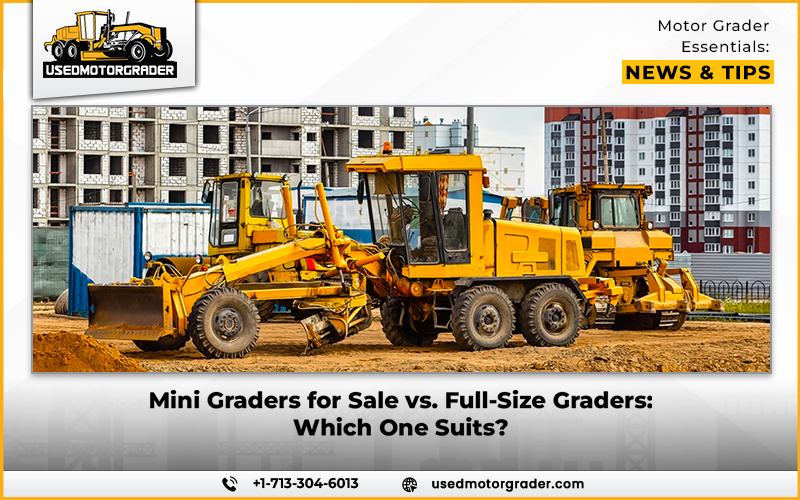Graders help construction projects succeed by arthmoving projects, shaping the terrain for roads, building foundations, and landscaping. Selecting the correct grader size makes operations more efficient and cost-effective while helping projects succeed. Despite their common use on big projects, full-size graders have lost popularity to mini graders because of their easy handling and affordable price. Contractors could know the differences between these two options to pick the best equipment solution that matches their unique tasks.
What are Mini Graders?
Mini graders are compact grading machines designed to perform fine grading tasks and serve smaller job sites. These machines weigh less than their larger versions and function well in limited spaces because they are easy to move around. Builders and landscape teams use this equipment at private road locations, driveways, and small construction sites. The machines work well in restricted spaces, which contractors use to complete projects on residential and commercial sites.
Pros and Cons
Mini graders help users save money because of their lower operating costs. These machines need less fuel and less maintenance than larger graders. Since they are easier to handle, their operations can be assigned to workers who have basic training. However, mini graders have limitations. The machines perform weak grading operations and lack the power for demanding tasks. Smaller blade dimensions on these machines make larger tasks take longer to accomplish. Contractors should decide if maneuverability and accuracy matter more than power when looking for mini graders for sale.
Functionality of Full-Size Graders
Full-size graders handle heavy jobs by performing grading tasks and roadwork on large sites. These graders perform better than standard models due to their strong engines and wide blades, so projects in highway construction, mining, and agriculture require them. Their high performance capabilities, together with GPS automation and steering flexibility, make them suitable for difficult construction work.
Pros and Cons
Full-size graders deliver faster work output than other types of equipment. They travel quickly over large distances to finish jobs sooner and save money on workforce needs. Their strong construction allows them to survive many years and remain a great financial choice. However, these features bring higher costs to the project. Buying and maintaining full-size graders costs much more than other models. They need trained operators, consume more fuel, plus need bigger storage space to operate well. Because of their size, these machines do not perform well in urban construction areas that require tight maneuverability. Contractors who operate on small infrastructure projects find full-size graders unnecessary due to their equipment size.
Cost Comparison: Mini Graders vs. Full-Size Graders
Purchasing a grader impacts contractors financially more than anything else. Mini graders come at budget-friendly rates between $30,000 and $80,000 due to their reasonable models and available brands. Full-size grader models usually have a price range between $150,000 and half a million dollars or more. Small contractors and businesses can start their grading operations with mini graders because of their lower purchase price.
Operational costs are another factor. Mini graders need less fuel and cost less to maintain, which produces lower budget expenses over time. Full-size graders return more money when sold because companies need them for extensive grading jobs. Deciding between mini graders for sale and full-size graders depends on the project demands and available financial resources.
Efficiency & Performance
Project characteristics determine if users should choose a mini or full-size grader machine. The mini grader creates accurate results when working on delicate landscaping tasks or road projects that need smaller equipment. Their small size lets them work effectively in tight areas that would block a regular grader. The strength of full-size graders and their wide blades make them superior at handling big land-grading operations and road construction work.
Comparison of Both Sizes
Comparing these machines by their accuracy and strength helps users make better choices. Mini graders provide precise grading and leveling, while full-size graders offer better earthmoving capacity for extensive projects. Working conditions at the construction site affect the choice between different types of graders. Urban projects or smaller job sites require contractors to opt for mini graders for sale, while open road work demands full-size grader machines. Contractors need to study project requirements to select the grading machine that performs best.
Which One Should You Choose?
The selection of a suitable grader depends on multiple project and operational aspects such as budget, project scale, and usage requirements. The mini grader suits residential and small commercial projects because it offers affordable features for easy operation. Major construction companies working on infrastructure projects will gain the most from the strength and efficiency of big graders.
Companies that do both minor and major projects should look for mini graders for sale for regular use and rent a full-size grader only when necessary to reduce expenses. Business owners need to evaluate operator availability, job location, and long-term value before choosing their final graders. By looking at work demands, space needs, and investment returns, a firm or contractor can choose between a mini or full-size grader.


